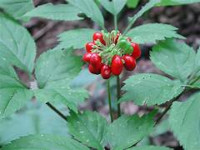Lactagogue Activity of Aqueous Extract of Javanese Ginseng Leaves on Wistar Mice
http://www.doi.org/10.26538/tjnpr/v7i8.11
Keywords:
Breast milk production, lactagogue, infusion extract, Javanese ginseng leafAbstract
The plant known as Javanese ginseng (Talinum paniculatum Gaertn) contains polyphenols, steroids, flavonoids, and other chemical substances that can enhance breast milk production by stimulating the mammary glands to make more milk. This study aims to investigate the potential of Javanese ginseng leaves to induce milk production in adult mother mice. The infusion technique
was used to extract the ginseng leaves. The amount of breast milk reflected by the mice's weight before and after breastfeeding is used to calculate the possibility of increasing breast milk. The 25 mother mice used in this study were separated into five groups, including the normal control group (which received NA-CMC 0.5%), the positive control group (which received a commercial
breastfeeding promoter including katuk plants at a dose of 117 mg/kg BW), and group D1 (which received a 5000 mg/kg BW infusion of Javanese ginseng leaves), group D2 (which received a 2500 mg/kg BW infusion of Javanese ginseng leaves), and group D3 (which received a 1250 mg/kg BW infusion of Javanese ginseng leaves). The results showed that mother mice that received Javanese ginseng leaf infusion produced more breast milk than the normal controls. Mother mice given 5000 mg/kg of Javanese ginseng leaf infusion showed the highest percentage (13%) increase in breast milk production. However, its capacity to do so was less than commercial breast milk-promoting products, with a 26% increase in breast milk production. We conclude that Javanese ginseng leaf extract used by
breastfeeding mothers could enhance breast milk production.
References
Suwanti, Endang, and Kuswati. “Pengaruh Konsumsi Ekstrak Daun Katuk Terhadap Kecukupan ASI Pada IbuMenyusui Di Klaten” JTIK. 2015; 52:132–35.
Widia, Lidia; Meihartati, Tuti. "Oxytocin Massage Enhanced Breast Milk Production in Post Partum Women" Majalah Obsteri & Ginekologi. 2017; 25(2): 63-65.
Dewi, Ayu Devita Citra. “Faktor-Faktor Yang Mempengaruhi Kelancaran Produksi ASI.” Jurnal ’Aisyiyah Medika. 2019; 4(1): 1-7.
Badrunasar, Anas, dan Harry Budi Santoso. Tumbuhan LiarBerkhasiat Obat. Bogor: Forda Press; 2016.
Santoso, A.M., M. Amin, S.B. Sumitro, and B. Lukiati. LC MS Determination of Java Ginseng (Talinum paiculatum) Ginsenoside. Proceeding of 3rd International Biology Conference "Biodiversity and Biotechnology for Human Welfare".Surabaya; 2016. 3-6.
Adhami S, Siraj S, Farooqi H. Unexplored medicinal plants of potential therapeutic importance: A review. Trop J Nat Prod Res. 2018;2(1):3-11.
Septiani, D., M. Angelina, and D. Kusmana. Aphrodisiac activity of Java Ginseng (Talinum paniculatum Gaertn.) leaves ethanolic extract on the libido of Wistar male rats (Rattus norvegicus). Hermina Health Sci. J. 2021. 1(1):27-33.
Setyani, Wahyuning, Hanny Setyowati, and DewiAyuningtyas. “Pemanfaatan Ekstrak Terstandardisasi DaunSom Jawa (Talinum paniculatum (Jacq.) Gaertn) dalam Sediaan Krim Antibakteri Staphylococcus aureus.” Jurnal Farmasi Sains Dan Komunitas. 2016; 16(1):90
Mohanty, I., M. R. Senapati, D. Jena, and P. C. Behera. "Ethnoveterinary Importance of Herbal Galactagogues - aReview." Veterinary World. 2014. 7(5):325–30.
Al-Snafi, Khorsheed, and Farj. "Galactagogue Action of the Crude PhenolicExtracts of Grape Seeds (Vitis Vinifera)."International Journal of Biological & Pharmaceutical Research. 2015; 6(8):577–80.
Li M, Hassan FU, Tang Z, Peng L, Liang X, Li L, Peng K, Xie F, Yang C. Mulberry Leaf Flavonoids Improve Milk Production, Antioxidant, and Metabolic Status of Water Buffaloes. Front Vet Sci. 2020; 4(7). 599. doi: 10.3389/fvets.2020.00599.
General Director of Pharmaceutical Care and Medical Devices. Indonesian Herbs Pharmacopoeia. (2nded). Jakarta: Ministry of the Health Republic of Indonesia; 2017.
Farnsworth NR. Biological and Phytochemical Screening of Plants. J Pharm Sci. 1966; 55 (3):225-276.19.
Harborne, JB. Phytochemical methods: A guide to modern techniques of plant analysis. (2nd ed). London: Chapman and Hall. 1998
Whary MT, Baumgarth N, Fox JG, Barthold SW. Biology and Diseases of Mice. Laboratory Animal Medicine. 2015:43–149.
Iwansyah, Ade Chandra, Muhammad Rizal Martua Damanik, Lilik Kustiyah, and Muhammad Hanafi. “Potensi Fraksi Etil Asetat Daun Torbangun (Coleus amboinicus L.) Dalam Meningkatkan Produksi Susu, Bobot Badan Tikus,Dan Anak Tikus.” Jurnal Gizi Dan Pangan. 2017; 12(1):61–68.
Mustofa, Yuliani FS, Purwono S, Sadewa AH, Damayanti E, Heriyanto DS. Polyherbal formula (ASILACT®) induces Milk production in lactating rats through the Upregulation of α-Lactalbumin and aquaporin expression. BMC Complement Med Ther. 2020;20(1):368.
O. Oseghale, I., O. Imieje, V., Erharuyi, O., Iheanacho, C., & Falodun, A. A Review of the Phytochemistry and Pharmacology of Eleusine coracana Linn (Poaceae): A Popular Nigerian Edible Grain. Trop. J. Nat. Prod. Res, 2017;1(6), 227–235.
Muranishi Y, Parry L, Averous J, Terrisse A, Maurin AC, Chaveroux C, Mesclon F, Carraro V, Bruhat A, Fafournoux P, Jousse C. Method for collecting mouse milk without exogenous oxytocin stimulation. Biotechniques. 2016;60(1):47-9.
Rosalinda Sinaga, Tondi. “Manfaat Buah Pepaya TerhadapKelancaran Proses Menyusui Pada Ibu Nifas.” Jurnal Penelitian Perawat Profesional . 2020; 2:301–8.
Okinarum, Giyawati Yulilania, Lestariningsih Lestariningsih, dan Afroh Fauziah. “Potensi Teh JantungPisang Batu (Musa Balbisiana Colla) Sebagai GalaktagogDalam Meningkatkan Kadar Prolaktin Serum Selama MasaLaktasi.” Jurnal JKFT. 2020; 5(2):54.
Dou ZB, Xin CJ, Feng ZC, Dan BY, Yuan LW, Li W, et al. Sauropus androgynus L. Merr.-A phytochemical, pharmacological and toxicological review. J Ethnopharmacol. 2020. 257:112778.
Menezes FDAB, Ishizawa TA, Souto LRF, Oliveira TF. Talinum paniculatum (Jacq.) Gaertn. leaves - source of nutrients, antioxidant and antibacterial potentials. Acta Sci Pol Technol Aliment. 2021;20(3):253-263
Oktarina, Oktarina Oktarina, and Yurika Fauzia Wardhani. “Perilaku Pemenuhan Gizi Pada Ibu Menyusui Di BeberapaEtnik Di Indonesia.” BuletinPenelitian Sistem Kesehatan. 2020; 22(4):236–44.

Published
How to Cite
Issue
Section
License
Copyright (c) 2023 Tropical Journal of Natural Product Research (TJNPR)

This work is licensed under a Creative Commons Attribution-NonCommercial-NoDerivatives 4.0 International License.


















